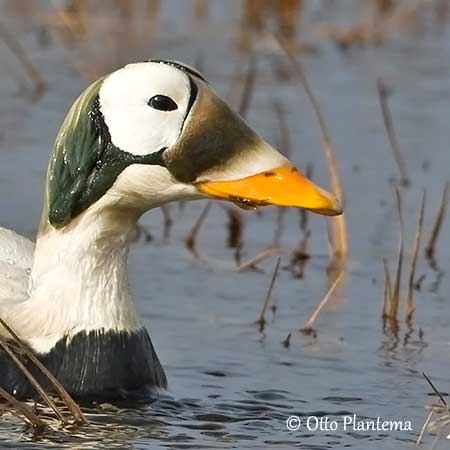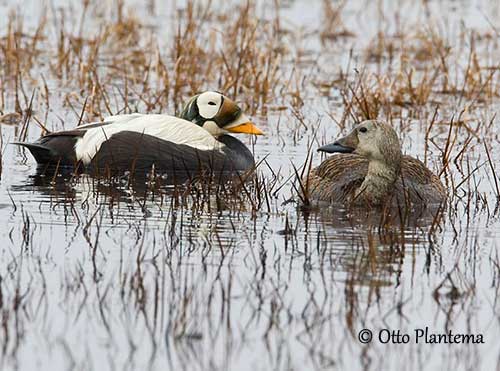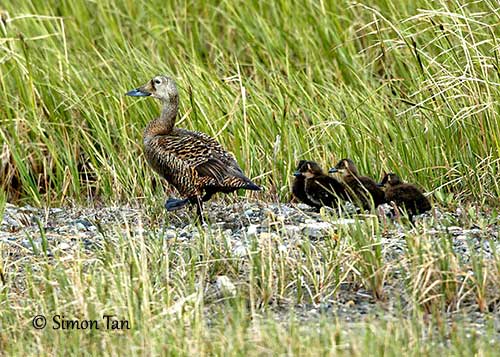Fr: Eider à lunettes
Ang: Spectacled Eider
All: Plüschkopfente
Esp: Éider de anteojos
Ita: Edredone dagli occhiali
Nd: Brileider
Sd: Glasögonejder
Photographer:
Otto Plantema
Trips around the world
Simon Tan
PBase Bird galleries
Text by Nicole Bouglouan
Sources:
HANDBOOK OF THE BIRDS OF THE WORLD vol 1 by Josep del Hoyo-Andrew Elliot-Jordi Sargatal - Lynx Edicions - ISBN: 8487334105
THE HANDBOOK OF BIRD IDENTIFICATION FOR EUROPE AND THE WESTERN PALEARCTIC by Mark Beaman, Steve Madge - C. Helm - ISBN: 0713639601
GUIDE DES CANARDS, DES OIES ET DES CYGNES – de Steve Madge - Delachaux et Niestlé - ISBN: 2603013769
Animal Diversity Web (University of Michigan Museum of Zoology)
Defenders of Wildlife – Spectacled Eider
SeaWeb – Ocean Issue briefs – Spectacled Eider
Alaska Department of Fish and Game
Eiders... four really strange ducks
Spectacled Eider
Somateria fischeri
Anseriformes Order – Anatidae Family
INTRODUCTION:
The Spectacled Eider is included in the subfamily Anatinae, tribe Mergini, in the large family Anatidae. However, the eiders are sometimes placed in their own genus Somateriini. The three eiders of genus Somateria, the Common Eider, the King Eider and the Spectacled Eider are very closely related. The fourth species, the Steller’s Eider of genus Polysticta, is more distinctive and is probably the link between eiders and other sea ducks.
The Spectacled Eider ranges in the Bering Sea where it usually occurs in small flocks. It frequents remote habitats often far from humans. It is uncommon and poorly known, and its almost ghostly appearance makes the bird wrapped in an aura of mystery.
DESCRIPTION OF THE BIRD:
Biometrics:
Length: 50-58 cm
Weight: M: 1275-1750 g – F: 1125-1850 g
The adult male is striking with unique facial pattern. In breeding plumage, chin, throat, neck and back are white, whereas breast, rump, tail and belly are blackish. The underwing is mostly dark grey with pale marginal coverts and axillaries.
On the head, crown and nape are pale greenish, with shaggy feathers on nape. The long, sloping, feathered, brownish forehead extends down to the nostrils where it ends in a white band. The eyes are surrounded by large white “spectacles” bordered by narrow black rim, giving the bird its name.
The bill is yellow-orange with pale nail. The iris is white with blue iris ring. Legs and webbed feet are pale yellow.

The female in breeding plumage is dull brown with darker brown barring. Head and neck are paler brown with black streaks. Lower breast to belly is dark brown with little or no barring.
The head pattern is visible but much duller than in male. The bill is dark greyish-blue with paler nail. The eyes are dark brown. Legs and feet are dull olive-brown.
The juvenile male has slightly developed spectacles and resembles female. It may appear darker above and slightly barred dusky below. Scapulars show parallel barring.
Juvenile and subadult females resemble adult until the second year. But the plumage pattern is indistinct, with paler brown mottling and less distinct barring on body. The head pattern is indistinct and the bill is darker.
The male in eclipse resembles other large eiders. It lacks white on breast at any stage. Head, neck and back are mostly greyish, but it retains the white wing-coverts. It is duller and dark greyish overall.
RANGE:
The Spectacled Eider breeds along the coasts of N Siberia, from Lena Delta E to N and W Alaska. Most of them winter in the Bering Sea among sea ice, in pack ice openings (polynyas), although they have been recorded in the Aleutian Islands, Kenai Peninsula and Kodiak Island.

HABITAT:
The Spectacled Eider nests on shorelines, peninsulas and small islands, often near water although they may nest more than 100 kilometres inland in Siberia. They can be seen on small lakes and pools, also streams on subarctic and arctic tundra.
Their breeding areas in Siberia and Alaska include salt marshes and freshwater ponds with small islands, wet meadows, low ridges and mounds of earth covered with ice.
After breeding, they gather on shallow waters off Alaskan and Siberian coasts for moulting during one-two months. They are unable to fly and vulnerable to predation. Then, they reach their wintering range south of St. Lawrence Island. They are marine during winter, and occur well offshore to pack ice.
CALLS AND SONGS: SOUNDS BY XENO-CANTO
The Spectacled Eider male is usually silent, but during the breeding season, the female gives repeated, guttural croak calls if disturbed, and repeated clucking “buckBUCK-buckBUCK-buckBUCK” when she is with the ducklings. The male utters a weak cooing during the courtship displays.
BEHAVIOUR IN THE WILD:
The Spectacled Eider feeds mainly on molluscs, including clams and gastropods during the breeding season and when they are at sea.
During the summer on the tundra, it feeds on aquatic insects and some crustaceans with in addition various plant materials such as sedges, grasses and berries.
On tundra, it forages by dabbling in shallow water or by walking on land. At sea, it forages by diving and swimming underwater.
The pair forms during winter, before to return to the breeding grounds. The male performs typical courtship displays including rearing up out of water, wing-flapping, shaking head, stretching neck upwards and jerking head back in quick motion. The male leaves the breeding grounds after the laying, and the female incubates and rears the chicks alone.
The Spectacled Eider winters in NC Bering Sea. This area varies depending on extension of pack ice and polynyas.
Its flight is faster and more agile than that of the largest eiders.
REPRODUCTION OF THIS SPECIES:
The Spectacled Eider returns to the breeding grounds in May-June. They nest in single pairs or in loose groups, with the nests placed between 5 and 600 metres apart. The nesting-site is usually on shorelines, peninsulas and islands, often in small ponds.
The female builds the nest on the ground, a bowl-shaped depression made with a layer of sedges and grasses, and lined with down.
PROTECTION / THREATS / STATUS:
The Spectacled Eider is threatened by entanglement in fishing gear during the moulting period. Ingestion of lead shot accumulated in pond sediment on the breeding grounds is an important threat. Predation by foxes and large gulls on eggs and chicks involves nest failures. The global warming is a problem in the wintering range as it is altering the ecosystem of this area. The ice is replaced by open water, and warmer temperatures reduce the prey’s availability. In the same way, higher temperatures involve the drying of wetlands in the breeding range.
The global population is estimated at 330,000/390,000 individuals (2006), but important declines are reported in Alaska.
However, in spite of suspected decrease, the Spectacled Eider is currently evaluated as Least Concern.
She lays 4-5 creamy-white eggs with scattered pale buff spots. The male leaves the female at the beginning of the incubation which lasts 23-24 days. At hatching, the ducklings have brown down above and paler below. The spectacles are already visible. The bill is greyish brown. They are able to walk, swim and feed within 1-2 days. Two months later, they are fully grown and ready to migrate to the wintering grounds.
Nest failure is often due to gulls and skuas, American Mink (Mustela vison), Red foxes (Vulpes vulpes) and Arctic foxes (Vulpes lagopus).
